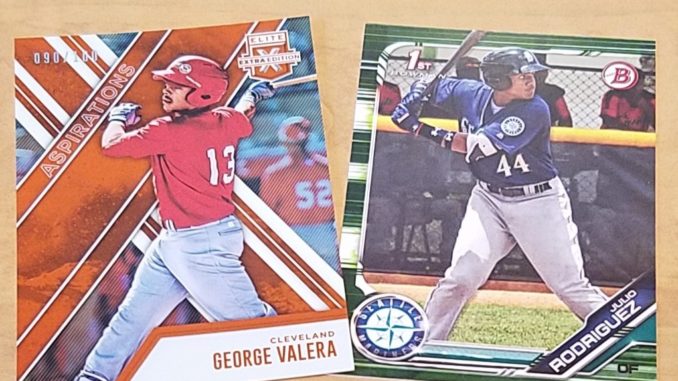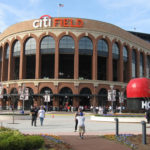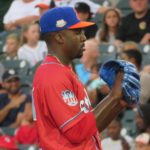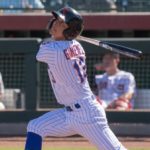
In the world of Greek Mythology, there exists a big 3 of Gods: Zeus, Hades, and Poseidon, all far superior than any mortal, whose powers are only matched by each other. While each God possesses a unique set of abilities and powers, the three are equally matched overall. In the world of young outfield prospects, the 3 Gods are Kristian Robinson, George Valera, and Julio Rodriguez. These 3 prospects, all born late in the year 2000, possess the tools and the potential to take the world of baseball by storm. That being said, tools alone may be nice, but all three also impressed in their professional debuts, all at the age of 17. As the season gets started, these three are among everyone’s obsessions, and all eyes are on them for this coming year. A solid performance from any of them could skyrocket their stock. If you told me that one year from now, all three of them will be top 20 prospects, I would not be surprised at all, they’re all that good. That being said, the three of them aren’t just one entity. Much like the Greek Gods, they have very different abilities and skill sets, and come from completely different places. Different builds, different tools, different approaches. All three have insane amounts of talent, but they’re completely different players. What I’m going to do in this article is attempt to compare and contrast them, and give an overview of what the future holds for these young studs.
Kristian Robinson, OF – ARI
DOB: 12/11/2000
The Bahamas is becoming much more than just a vacation spot in the world of baseball recently. Starting with Andre Rogers in 1957, the first Bahamian to play in the MLB, there has been a total of 6 MLB players from the Bahamas. With guys like Jazz Chisholm, Lucius Fox, Trent Deveaux, D’Shawn Knowles, and Kristian Robinson himself all in the minors today, that number will be growing very soon. Robinson has a very good chance to be the best of this group.
Just cause AFL started doesn’t mean ‘structs is over. Here’s #Dbacks Kristian Robinson taking BP with Ice Ice Baby playing on the PA. Future 7 Raw; rocks mic like a vandal. pic.twitter.com/mdiaQQK1VE
— John T Eshleman (@2080_John) October 10, 2018
Standing at 6’3” 190 pounds, the 18-year-old Kristian Robinson looks more like a wide receiver than a baseball player. The physical tools are obviously what stands out for Robinson, as he could very well possess 70+ raw power and 60+ speed. The 7 HR in his rookie ball debut aren’t a clear indicator of the power he possesses, as you have to remember he was an extremely raw 17 year old facing much older, much more experienced competition. The 12 SB in just 57 games are also impressive, about a ~30 steal pace, but he got caught stealing 8 times, showing that his instincts for baserunning might be a bit behind. Most also believe that as he adds weight in muscle, he will lose a few steps in terms of speed, which I don’t think is outlandish. Either way, I think Robinson could very well be a 15-20 SB guy in the majors. All that being said, the slashline from Robinson is very impressive. Players as raw as Robinson at only 17-years-old rarely make their debuts stateside, but Robinson not only debuted, but he held his own. Between the Arizona Fall League and the Pioneer League, both Rookie Ball levels, Robinson slashed .279/.363/.428, while sporting a 26.2 K% and a 10.5 BB%. While that K% is a bit rough, it’s to be expected from a prospect as raw as Robinson facing older competition, and the BB% shows that Robinson’s approach is fairly advanced given where he is in terms of development. Robinson’s bat to ball skills as he ascends through the minor leagues will be key in determining his ceiling.
As with all prospects, there are a few concerns about Robinson’s game which people believe have the potential to hold him back, with the biggest being the hit tool. As previously mentioned, a 26.2 K% is far from ideal, and while some believe he will refine his approach and improve on this, others believe that as he moves up the ladder and faces greater competition, he will struggle to make contact even more. Having only played in rookie ball, no one truly has the answer to this question, and only time will tell how he will handle better pitching.
My guy @Dbacks OF prospect Kristian Robinson (@krobbie_242 ) with a killer pro debut. 3-5 with a SB. The speed caught me off guard. Reminded me of Estevan Florial 💨, Approach at the plate is 💪. Here are those hits #ProspectOne pic.twitter.com/76sagntzHm
— The Welsh (@IsItTheWelsh) June 19, 2018
The other main concern people have is in regards to the aforementioned potential loss of speed. At only 18 years old, Robinson’s 6’3” frame has plenty of room for adding muscle and bulk, which will do wonders for his power, but will potentially hurt his speed a bit. Robinson made most of his starts at CF last fall, and projects to stay there moving forward, but many think he will outgrow the position and move a corner outfield spot. Robinson’s bat is still incredible even in right or left, but if he can stay in center, his value will just be even higher.
I personally think that comps for a guy as raw as Robinson are a bit pointless, as the way they progress can vary so much, but it’s still fun to speculate. One comp that I’ve seen thrown around is Justin Upton, and I think that it’s a pretty solid one. Upton, the former #1 pick, also came up through the Diamondbacks system as a CF with an unlimited amount of potential. As many people speculate with Robinson, Upton eventually ended up moving to RF, and now LF, but Robinson is a bit more athletic than Upton, so I believe he can stay in CF. Upton was also far more advanced with the bat than Robinson was at 18, and was able to make the majors at 19, whereas Robinson is likely still a few years away. Overall, I think Justin Upton’s 2017 season, in which he slashed .273/.361/.540 with 100 Rs, 44 2B, 35 HR, 109 RBI, and 14 SB is a distinct possibility for Robinson.
While I was hoping to see Robinson go to Low-A this spring, it seems that we will have to wait until mid-June to see Robinson, when he’ll likely return to rookie ball. Pay very close attention to how Robinson plays throughout this season, especially his approach and power.
George Valera, OF – CLE
DOB: 11/13/2000
George Valera is not the typical international prospect. Born and raised in New York, Valera moved to the Dominican Republic at the age of 13, and signed with the Indians at the age of 16. Despite just 6 professional games under his belt, and despite only being 18 years old, George Valera is already seen as one of the best pure hitters in the minor leagues. His potential teammate Jose Ramirez went as far as to call him “the next Indians superstar”, and he might not be too far off. Valera has the type of swing from the left side that coaches, fans, and scouts alike will drool over. With shades of Robinson Cano in his swing, Valera possesses a smooth and consistent stroke, with the ability to spray the ball all over the field. His above-average bat speed also allows him to develop quite a bit of power, despite only being 5’10” and between 160 and 170 pounds. Just how much power Valera will generate is to be seen, but I think 20 HRs should be extremely doable for him, and he could be a consistent .300 hitter.
If you want to get to know the next #Indians superstar follow @GV13__ #RollTribe
— Jose Ramirez (@MrLapara) November 11, 2018
Outside of his bit, Valera possesses fairly average tools across the board. His arm projects to be above average, with speed being slightly below average, leading many to believe his future is in RF, but Valera wants to stay in CF. I personally believe he will end up in RF, but the Indians will develop him as a CF for now, so it’ll be interesting to see how he develops there. Like Robinson, however, Valera’s bat will provide value wherever he plays in the field.
Compared to Robinson, Valera’s ceiling isn’t quite as high. He’ll likely never have 40 HR power, or 30 SB speed, but he also has a much higher floor. Valera’s advanced approach and fine-tuned mechanics should allow him to move quickly through the Indians system, although like Robinson, the Indians chose to not send Valera to Low A to start the season.
In terms of a comp for Valera, Robinson Cano is the obvious one at the plate given the similarities in their swing, although I’m not sure Valera will ever reach the high 20s and low 30s in HR like Cano has a few times in his career. From 2006-2009, Cano’s age 23 to 26 seasons, he averaged 18 HR, 42 2B, 82 R, 82 RBI, and a .309/.343./.484 slashline, which I believe is a decent projection for Valera, with more Rs or RBI depending on where he hits in the order. There’s also the potential that Valera truly taps into his power and becomes a guy who hits 30+ HR, but that remains to be seen. Another comp that I like personally is former Indian Michael Brantley, with Brantley’s 2014 being a great benchmark for Valera. I think Juan Soto also provides an example for an extremely advanced left handed hitter, and I believe Valera could follow a similar path. A left handed Keston Hiura is also a good comparison for Valera in terms of fitting the “pure hitter” description.
Dominican Prospect George Valera draws alot of comparisons to @robinsoncano because of his swing. His… https://t.co/6UtLIUunVo pic.twitter.com/HNR288Gq2Y
— HundredTenPercent (@HTP110) January 16, 2017
The Indians have been a bit timid with Valera so far, although an injury last year played a part in that, but I really hope that they promote Valera aggressively, as I think he is already way too good to be playing anywhere lower than High-A, possibly even AA.
Julio Rodriguez, OF – SEA
DOB: 12/29/2000
When the Mariners announced their minor league rosters, I was extremely excited to see the West Virginia Power’s roster, featuring possibly the best OF duo of any minor league team in Jarred Kelenic and Julio Rodriguez. While this was seen as an aggressive move for Rodriguez, who had not yet made his debut in America (outside of 7 Spring Training AB), Rodriguez was thriving before his injury. Though it’s a small sample size, Rodriguez looks very mature at the plate. In a league where the average player is about 4 years older than him, Rodriguez is 11/35 (.355 AVG) so far, with 3 2Bs, as well as 4 BB and 5 K, demonstrating an extremely advanced approach for his age. This hot start is sure to silence naysayers, who believed that his performance in the DSL last year, where he slashed .315/.404/.525 with 5 HR, 13 2B, 9 3B, as well as 30 BB to 40 K in 59 games, could be chalked up to weak competition.
He’s just 18, but @J_RODrodiguez44 is already imagining what it will be like to play in Seattle.
Get to know one of the most exciting Mariners prospects. 👀 pic.twitter.com/hxmEortzdZ
— Seattle Mariners (@Mariners) January 31, 2019
At the plate, Rodriguez draws many similarities to Robinson. At 6’3” 180 pounds, Rodriguez is a physical specimen, with tons of raw power. Like Robinson, his in-game power hasn’t completely been on display yet, but the 13 2B and 9 3B that he hit in the DSL will soon turn in to HR as his body continues to develop. Much like Robinson, many believe that Rodriguez has upwards of 70 power, and some have compared him to White Sox prospect Eloy Jimenez.
Where Robinson and Rodriguez mainly differ are in athleticism and approach. Rodriguez is far less athletic than Robinson. He possesses a similar frame, as well as the strength and power that come with it, but Rodriguez is easily a below average runner, and will probably get even slower as he adds bulk. Whereas Robinson has 60+ speed upside, Rodriguez probably tops out at 45. Rodriguez makes up for it in his approach though. As demonstrated by his 30:40 K:BB ratio, or 11.8 BB% and 15.8 K%, Rodriguez is a professional hitter, and has no issue making contact or drawing walks. I think that in terms of approach, Rodriguez falls right in the middle of Valera and Robinson, which should allow him to contribute a good average and on-base percentage, on top of the obvious power.
Unlike Valera and Robinson, there’s not too much question about where Rodriguez will play moving forward. Rodriguez has made a couple starts in CF this year, and made a few starts there last year, but his below average speed and plus arm will keep him in RF moving forward.
One of the concerns about Rodriguez that I’ve seen is his swing mechanics. While he possesses elite bat speed, Rodriguez has a very active and unorthodox stance, with a lot of moving parts, which makes repetition a bit difficult. If you watch his swing, it’s definitely not something that a hitting coach would use as an example to teach players, although it seems as if it’s gotten better since coming to the states. Personally, I see this as a reason for excitement. Mechanics issues usually lead to strikeout issues, but that hasn’t been a problem for Rodriguez. I believe that working with professional coaches, he’ll be able to tweak his swing for the better, and will become an even more advanced hitter than he already is. The success he’s achieved despite his faults, should be a sign that the sky’s the limit for this young Dominican phenom.
God’s plan‼️🙏🏽☄️ #JRODshow #blessed #onmyway🔝 #TrueToTheBlue pic.twitter.com/G3LI9mTVYl
— Julio Rodriguez🇩🇴 (@J_RODshow) March 16, 2019
I previously mentioned the Eloy Jimenez comparison, and while he still has a lot to prove to live up to that, Jimenez’ 60+ hit, 70+ power assessment could be the future for Rodriguez. He also offers more in terms of athleticism than Eloy, and should be a better fielder in right. I think in terms of a Major Leaguer you could compare him to, at the plate I think Eugenio Suarez with more power could be where he ends up.
Conclusion
ETA:
Despite the fact that I think Valera is the most advanced of the three, I think Rodriguez could move just as quickly, if not quicker, through the minor leagues. He’s already at Low A, and if he continues to play as he is right now, he could be in High A fairly soon. Unfortunately, the hand injury slows Rodriguez’s timeline, but in an ideal world, both Valera and Rodriguez will be at AA by seasons end, or at the very least the start of next year. I could see both debuting in 2020 if all goes perfectly, but I think 2021 is more accurate.
As for Robinson, he’ll likely take a little longer to work his way through the system, as he is so raw and needs the most development. Depending on how the Diamondbacks decide to move Robinson, I could see him making High A this year, but I think it’s more likely that they keep him in Low A for the year, and start him in High A next year. I think 2022 is the most likely ETA for Robinson, but 2023 could be possible if he happens to stumble in his development.
Ceiling:
I think it’s fairly clear that Robinson has the highest ceiling of the three. I’d even go as far as to say that Robinson’s ceiling is as high as almost anyone in the minors, rivaling guys like Wander Franco and Jo Adell. If his hit tool develops, and he can stay in CF, while stealing 25+ bases, there’s no telling how good he could be. I think Valera’s ceiling is probably a bit higher than Rodriguez, given the greater athleticism, and I also believe that if Valera develops power beyond what people are expecting, there’s no doubt in my mind that he’ll be a perennial all star. That being said, all three have extremely high ceilings.
Floor:
Valera’s floor is by far the highest of the 3, thus his risk is easily the lowest. I would be extremely surprised if Valera didn’t become at least an average MLB player, but the other two both have bust potential. I think Rodriguez’ floor is also quite a bit higher than Robinson’s, given his more advanced hit tool and approach, but I think you could argue that both have high risk factors, and could possibly end up being busts, but almost all prospects do have bust potential.
Personal Opinion:
I really like all 3 of these guys. I think there’s a lot of hype around all 3, but I think for the most part it is warranted. I think some people are a bit excessive (I’ve seen one person say they think Robinson will be #1 by years end), but for the most part I think people have been very reasonable with their assessments. I personally think all three will be top 50 by year’s end, and I wouldn’t be surprised if any of them was top 20. I honestly like Rodriguez the best, and think that Robinson has become just a bit over-hyped, but I’m extremely excited to see what the 2019 season has in store for all three.
Christian Kainer covers the New York Mets minor league system for Prospects1500. Christian is a native Mets fan living in New Jersey, and going to school the University of Notre Dame in South Bend, Indiana. Christian was introduced to sports by his brother and dad, but fell in love with baseball as he learned how much math is involved in every play. Follow him on twitter at @CJ_Kainer.





This was one of the best, in-depth looks with sound analysis at what I think will be the next wave of great young guys in a few years. Great work Will!
Thank you for the kind words! Very excited to see where these three go!
Excellent information and well written. Great job Will. You nailed it.